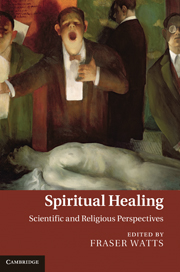Book contents
- Frontmatter
- Contents
- List of figures
- List of contributors
- Preface
- 1 Conceptual issues in spiritual healing
- 2 The historical Jesus and healing: Jesus' miracles in psychosocial context
- 3 The theology of spiritual healing
- 4 Healing the spirit: mystical Judaism, religious texts and medicine
- 5 Conceptualizations of spiritual healing: Christian and secular
- 6 The psychodynamics of spiritual healing and the power of mother kissing it better
- 7 Spiritual healing in the context of the human need for safeness, connectedness and warmth: a biopsychosocial approach
- 8 Modelling the biomedical role of spirituality through breast cancer research
- 9 Spirituality and health: assessing the evidence
- 10 Relating spiritual healing and science: some critical reflections
- 11 Concluding integration
- Bibliography
- Index
2 - The historical Jesus and healing: Jesus' miracles in psychosocial context
Published online by Cambridge University Press: 04 February 2011
- Frontmatter
- Contents
- List of figures
- List of contributors
- Preface
- 1 Conceptual issues in spiritual healing
- 2 The historical Jesus and healing: Jesus' miracles in psychosocial context
- 3 The theology of spiritual healing
- 4 Healing the spirit: mystical Judaism, religious texts and medicine
- 5 Conceptualizations of spiritual healing: Christian and secular
- 6 The psychodynamics of spiritual healing and the power of mother kissing it better
- 7 Spiritual healing in the context of the human need for safeness, connectedness and warmth: a biopsychosocial approach
- 8 Modelling the biomedical role of spirituality through breast cancer research
- 9 Spirituality and health: assessing the evidence
- 10 Relating spiritual healing and science: some critical reflections
- 11 Concluding integration
- Bibliography
- Index
Summary
The healing miracles of the historical Jesus may seem, at first sight, an unpromising, if not fanciful subject for critical study. Those unfamiliar with current scholarship might wonder how supernatural phenomena, such as miracles, can be the subject of serious historical scrutiny in the twenty-first century. In fact, regardless of what one thinks about the possibility of miracles (and, of course, this very much depends upon what one means by a miracle) most of those specializing in the study of the origins of Christianity believe that there are good grounds for holding that the historical Jesus was thought by his contemporaries, including both supporters and critics, to be an effective healer and exorcist. It is in this sense that the healings and exorcisms can be considered to constitute historical data and can be open to examination. Although subsequent generations of Christians would become almost fixated by Jesus' reputation as a miracle worker (Mathews 1999, pp. 54–91) and produced ever more elaborate and fantastical traditions, there are good reasons to look closely at the earliest records of this activity. Indeed, it is my contention that they can stand rather more scrutiny than they have so far received: if we look closely at the psychosocial dynamics that seem to characterize the healing activity of the historical Jesus as recounted in formative traditions about him, largely embedded in the synoptic gospels, we can go some way towards understanding how and why he acquired this reputation as an effective healer.
- Type
- Chapter
- Information
- Spiritual HealingScientific and Religious Perspectives, pp. 17 - 43Publisher: Cambridge University PressPrint publication year: 2011
- 11
- Cited by



